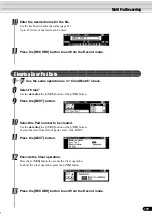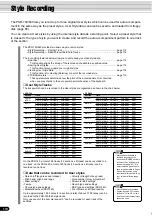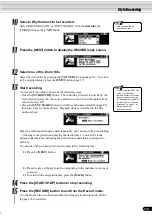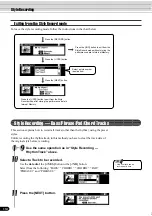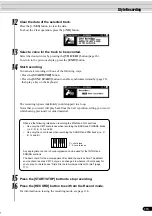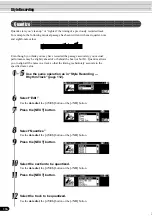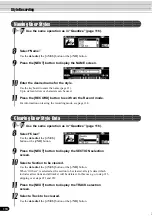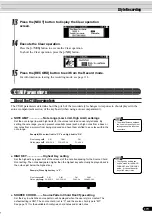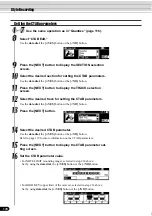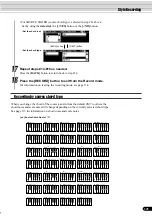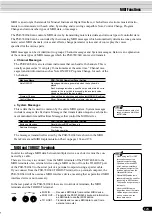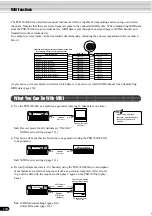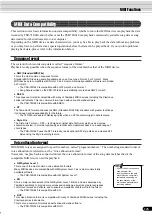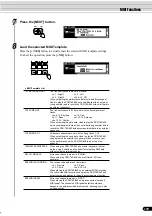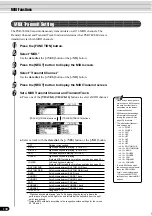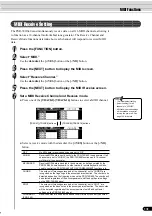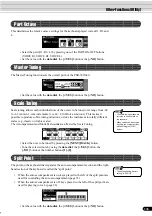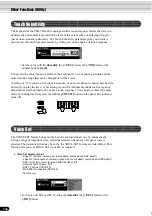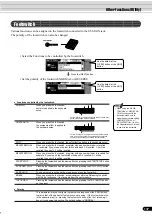
123
MIDI Functions
121
MIDI is an acronym that stands for Musical Instrument Digital Interface, which allows electronic musical instru-
ments to communicate with each other, by sending and receiving compatible Note, Control Change, Program
Change and various other types of MIDI data, or messages.
The PSR-740/640 can control a MIDI device by transmitting note related data and various types of controller data.
The PSR-740/640 can be controlled by the incoming MIDI messages which automatically determine tone generator
mode, select MIDI channels, voices and effects, change parameter values and of course play the voices
specified for the various parts.
MIDI messages can be divided into two groups: Channel messages and System messages. Below is an explanation
of the various types of MIDI messages which the PSR-740/640 can receive/transmit.
●
Channel Messages
The PSR-740/640 is an electronic instrument that can handle 16 channels. This is
usually expressed as “it can play 16 instruments at the same time.” Channel mes-
sages transmit information such as Note ON/OFF, Program Change, for each of the
16 channels.
●
System Messages
This is data that is used in common by the entire MIDI system. System messages
include messages like Exclusive Messages that transmit data unique to each instru-
ment manufacturer and Realtime Messages that control the MIDI device.
The messages transmitted/received by the PSR-740/640 are shown in the MIDI
Data Format and MIDI Implementation Chart on pages 163 and 178.
• The performance data of all
songs, styles and Multi Pads
is MIDI data.
Message Name
PSR-740/640 Operation/Panel Setting
Note ON/OFF
Messages which are generated when the keyboard is
played.
Each message includes a specific note number which corre-
sponds to the key which is pressed, plus a velocity value
based on how hard the key is stuck.
Program Change
Voice setting (control change bank select MSB/LSB setting)
Control Change
Mixer, Parameter Edit setting (volume, pan pot, etc.)
Message Name
PSR-740/640 Operation/Panel Setting
Exclusive Message
Reverb/chorus/DSP settings, etc.
Realtime Messages
Clock setting
Start/stop operation
MIDI and TO HOST Terminals
In order to exchange MIDI data between multiple devices, each device must be con-
nected by a cable.
There are two ways to connect: from the MIDI terminals of the PSR-740/640 to the
MIDI terminals of an external device using a MIDI cable, or from the TO HOST port
of the PSR-740/640 to the serial port of a personal computer using a special cable.
If you connect from the PSR-740/640 TO HOST terminal to a personal computer, the
PSR-740/640 will be used as a MIDI interface device, meaning that a specialized MIDI
interface device is not necessary.
In the rear panel of the PSR-740/640, there are two kinds of terminals, the MIDI
terminals and the TO HOST terminal.
●
MIDI IN ......... Receives MIDI data from another MIDI device.
●
MIDI OUT ..... Transmits the PSR-740/640’s keyboard information
as MIDI data to another MIDI device.
●
TO HOST ..... Transmits and receives MIDI data to and from a
personal computer.
• When using the TO HOST
terminal to connect to a
personal computer using
Windows, a Yamaha MIDI
driver must be installed in
the personal computer. The
included disk contains the
Yamaha MIDI driver.
• Special MIDI cables (sold
separately) must be used for
connecting to MIDI devices.
They can be bought at music
stores, etc.
• Never use MIDI cables
longer than about 15 meters.
Cables longer than this can
pick up noise which can
cause data errors.

